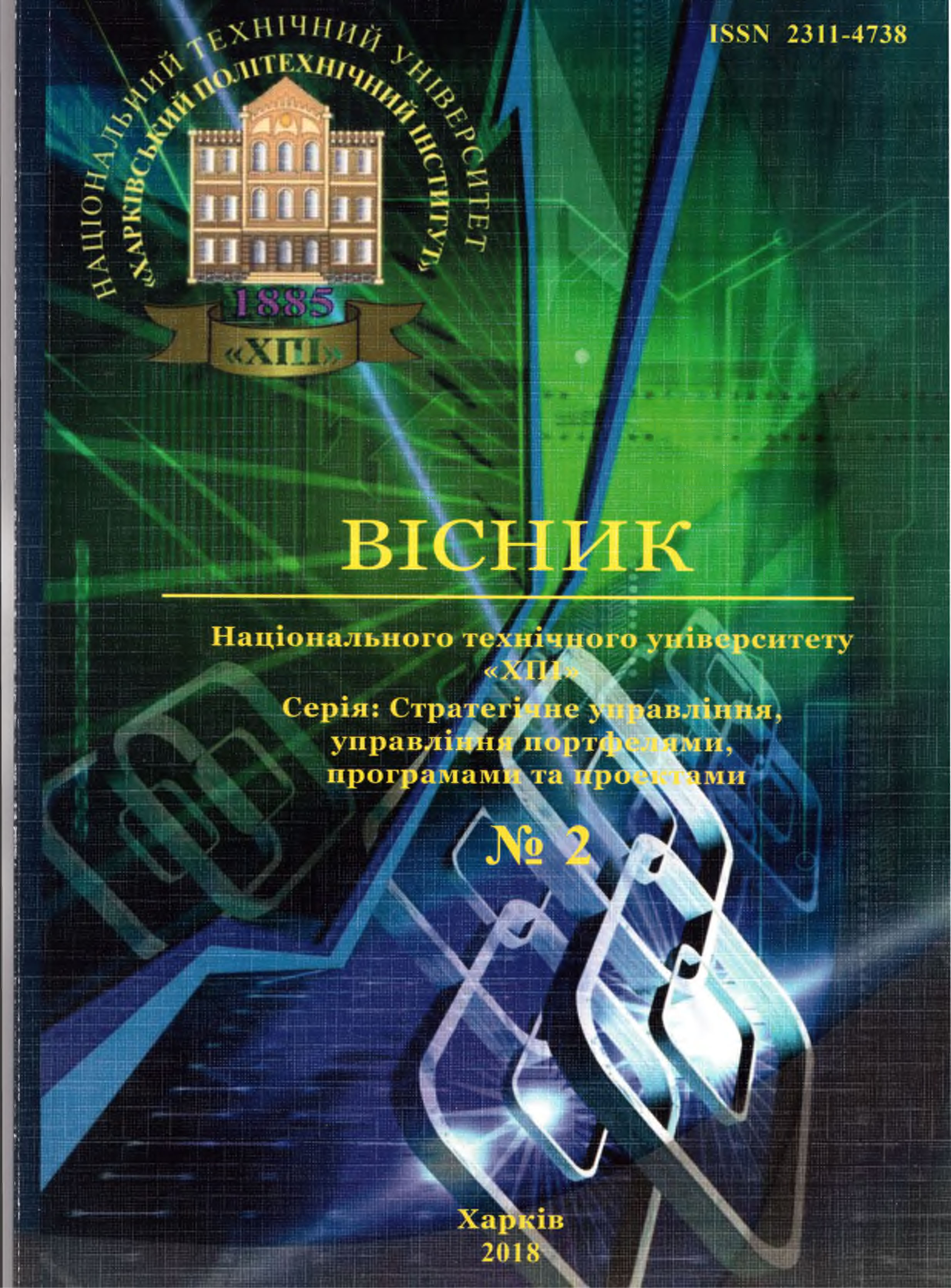THE RANGE METHOD USE FOR FORMING THE NECESSARY SET OF PROJECT TEAM COMPETENCIES
DOI:
https://doi.org/10.20998/2413-3000.2018.1278.5Keywords:
project team, competence, ranging, work structure, responsibility matrix, functional role.Abstract
There has been proposed a method of forming the necessary set of competencies for the purpose of its further use in the practice of project activity on the basis of ranging. The set of competencies is determined according to the specified work structure in the project. The evaluation of functions is carried out on the basis of filling in the responsibility matrix of the project team members. An example of the project of creating training courses in higher schools is considered. On the basis of this matrix, competences to perform certain tasks in the project were distinguished for the project team members. The selection of competencies was carried out according to three groups in the ICB 4 standard: Practice, People, and Perspective. The dependence of the specific weight of competence on its average rank is established. In accordance with the responsibility matrix, the correspondence between competencies and tasks being performed is determined. Using this method, it is possible to choose from the set of competencies of the ICB 4 standard those competencies that are necessary for the team members to implement a particular project, and to determine the weighting factors providing the accuracy of determining the necessary competencies for performing project tasks. The identification of the competencies required to fulfill a particular functional role of the project team members allows determining the compliance of the participant with a functional role when forming the project team. The application of the described method is necessary for solving problems related to the necessity for an objective assessment of potential project team members.References
Rach V. A., Cherepakha G. S. Model‟ opredeleniya ratsional‟noy roli chlena komandy proyekta [Model allowed to specify the rational role of a project team member]. Upravlinnya proektamy ta rozvytok vyrobnytstva [Project management and production development]. 2003, no. 3, pp. 70–79.
Coesmans P., Knoepfel H., Koch G. et al. IPMA Individual Competence Baseline ICB 4. International Project Management Association, 2015, 415 p.
Bushuyev S. D., Bushuyeva N. S., Neizvestnyy S. I. Mekhanizmy konvergentsii metodologiy upravleniya proyektami [Mechanisms for the convergence of project management methodologies]. Upravlinnya rozvytkom skladnykh system [Management of development of complex systems]. 2013, no. 12, pp. 5–17.
Bushuyev S. D., Kharitonov D. A., Rogozina V. B. Vektornaya model' razvitiya kompetentnosti organizatsiy v upravlenii proyektami [Vector model of competence development of organizations in project management]. Upravlinnya rozvytkom skladnykh system [Management of development of complex systems]. 2013, no. 14, pp. 5–17.
Widdet S., Hollifor S. Handbook of Competencies. Moscow, HIPPO, 2003, 224 p.
Kosenko V. V., Gakhov R. P. Primeneniye kompetentnostnogo podkhoda pri formirovanii komandy proyekta [Application of the competence approach in the formation of the project team]. East-European Journal of Advanced Technologies. 2013, no. 1/10, issue 61, pp. 174–178.
Chernega Yu. S., Kolesnikova K. V., Olekh T. M. Model' kompetentnosti menedzhera okhrany truda v forme matritsy otvetstvennosti [The competence model of the labor protection manager in the form of a responsibility matrix]. Upravlinnya rozvytkom skladnykh system [Management of development of complex systems]. 2015, no. 24, pp. 5–17.
Raven J. Competence in modern society: identification, development and implementation. Moscow, Kogito-Center, 2002. 396 p.
Sherstyuk O., Olekh Т., Kolesnikova K. The research on role differentiation as a method of forming the project team. Eastern- European Journal of Enterprise Technologies. 2016, no. 2/3 (80), pp. 63–68.
Lupuleac S., Lupuleac Z.-L, Rusu C. Problems of assessing team roles balance – Team design. Procedia Economics and Finance. 2012, vol. 3., pp. 935–940.
Liang H.-Y., Shih H.-A., Chiang Y.-H. Team diversity and team helping behavior: the mediating roles of team cooperation and team cohesion. European Management Journal. 2015, vol. 33, issue 1, pp. 48–59.
Gogunskii V., Kolesnikov O., Kolesnikova K., Lukianov D. Lifelong learning is a new paradigm of personnel training in enterprises. Eastern-European Journal of Enterprise Technologies. 2016, no. 4/2 (82), pp. 4–10.
Kolesnikov A. E., Lukіanov D. V., Vasilyeva V. Yu. Razrabotka modeli predstavleniya kompetentsiy v proyektakh obucheniya [Developing competencies representation model in education projects]. Visnyk NTU "KhPI" [Bulletin of the National Technical University "KhPI"]. Kharkov, NTU "KhPI" Publ., 2016, no. 1, pp. 61– 65.
Gogunsky V. D., Lukyanov D. V., Vlasenko E. V. Vyznachennya yader znan‟ na hrafi kompetentsiy proektnykh menedzheriv [Determination of nuclear knowledge the graph competence of project managers]. Eastern-European Journal of Enterprise Technologies. 2012, no. 1/10 (55), pp. 26–28.
Stahl G. K., Mäkelä K., Zander L.,. Maznevski M. L. A look at the bright side of multicultural team diversity. Scandinavian Journal of Management. 2010, vol. 26, issue 4, pp. 439 – 447.
Sherstyuk O. I. Mnogofaktornaya model' realizatsii funktsional'nykh roley v komande proyekta [Multifactor model for the implementation of project team functional roles]. Information Technologies and Interaction: III Intern. scientific-practical. conf. Kyiv, Ukraine, KNU im. Shevchenka, pp. 121–122.
Downloads
Published
Issue
Section
License
Copyright (c) 2018 Ольга Игоревна Шерстюк, Алексей Евгеньевич Колесников

This work is licensed under a Creative Commons Attribution-NonCommercial-ShareAlike 4.0 International License.
Our journal abides by the Creative Commons copyright rights and permissions for open access journals.
Authors who publish with this journal agree to the following terms:
Authors hold the copyright without restrictions and grant the journal right of first publication with the work simultaneously licensed under a Creative Commons Attribution-NonCommercial-ShareAlike 4.0 International License (CC BY-NC-SA 4.0) that allows others to share the work with an acknowledgement of the work's authorship and initial publication in this journal.
Authors are able to enter into separate, additional contractual arrangements for the non-commercial and non-exclusive distribution of the journal's published version of the work (e.g., post it to an institutional repository or publish it in a book), with an acknowledgement of its initial publication in this journal.
Authors are permitted and encouraged to post their published work online (e.g., in institutional repositories or on their website) as it can lead to productive exchanges, as well as earlier and greater citation of published work.

